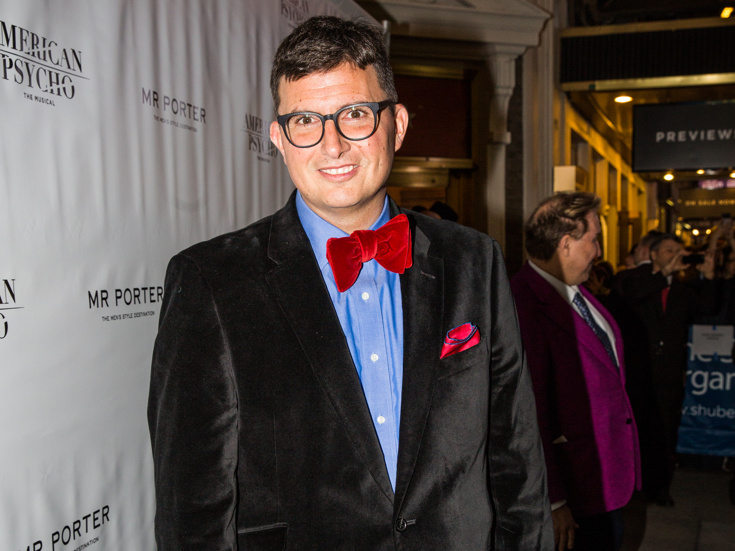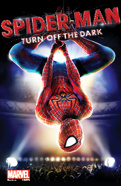'Fan-Boy' Roberto Aguirre-Sacasa on His Broadway Adventure Re-Working Spider-Man, Turn Off the Dark

(Photo: Caitlin McNaney for Broadway.com)
About the Author:
When the producers of Spider-Man, Turn Off the Dark sought a new co-writer to retool the book of the long-previewing musical extravaganza, they looked for a person who understood the world of superheroes. As luck would have it, Roberto Aguirre-Sacasa had penned several installments of Spider-Man and Fantastic Four comics in addition to his comic book-themed plays Based on a Totally True Story and Archie’s Weird Fantasy. He had also already reworked the 1966 Superman tuner It’s a Bird…It’s a Plane…It’s Superman. Below Aguirre-Sacasa recalls first viewing the Spider-Man musical as a fan, the busy creative period that followed once he joined the Spidey team and watching the show triumphantly defeat its naysayers as it swung into opening night.
![]()
One question I get asked a lot is: Which came first, writing plays or writing comic books? Growing up, the dream was always to be a playwright—certainly I’ve been a professional playwright longer than I’ve been a comic book writer—but I’ve been a fan-boy all my life. As a kid, I have vivid memories of my parents taking me and my older brother to the 7-Eleven to buy us Slurpees and all kinds of comic books—superheroes, Archie comics, horror comics, any- and everything. I used to trace the panels and then write new dialogue for the characters.
A couple of years ago, worlds collided when I got a chance to revise the book to the classic Charles Strouse/Lee Adams musical It’s a Bird…It’s a Plane…It’s Superman, about the iconic DC Comics superhero and his mild-mannered alter-ego, Clark Kent. It premiered at Dallas Theater Center last summer. That was an incredible experience—tons of fun—and (though I didn’t know it at the time) it was a great training ground for me to come aboard and help out on Spider-Man: Turn Off the Dark.
I’d heard about Spider-Man over the years, through the theater and comic book grapevines. Obviously I was familiar with [original director and co-author] Julie Taymor’s work, and U2’s songs, and I knew Glen Berger’s plays very well (Glen and I had actually gone to London together on a playwriting fellowship some years before), but until Spider-Man started previews, I had no idea what to expect.
For Christmas, my partner and treated ourselves to tickets to see the show, just as fans. Coincidentally, we ended up seeing the first performance after actor Christopher Tierney fell. At that point, it was hard to divorce the show from all the gossip and press it had received, but truthfully, we had a blast and the audience was electric. Then, in February, I got a call asking if I would be interested and available to work on the show. Having written Spider-Man comic books for Marvel, and having had a great time working on the Superman musical, it wasn’t a hard decision.
In March, the work began. Everyone involved with the show had gone through so much already—the original cast, the crew, the designers, the theater’s staff—but they all welcomed [creative consultant] Philip William McKinley, [choreographer] Chase Brock, and me with open arms. Especially, I have to say, co-writer Glen Berger. Believe me, that could’ve gone so many different ways, but it turned out great. And the best news was that everyone, from top to bottom, wanted to make the show as good as it could be, so it was like mobilizing one big army to accomplish this one common—albeit Herculean—goal.
The first thing that happened: Glen, Phil, and I met in a tiny office on Ninth Avenue for two or three days and just hashed out the story, moving scenes around and figuring out how to expand the emotional arcs of the characters. What would stay pretty much intact, what would need to be changed, that kind of conceptual stuff. My initial thoughts/hopes/dreams for the show basically matched up with what the rest of the team wanted. Again, we all had (basically) the same notes, the same wish-list—with some variation on how we might accomplish everything in the limited time we had. The core of the musical was all there—the Peter/Mary Jane romance, the flying, the villains—so it was really a question of deepening and bringing those elements forward.
Taking out the Geek Chorus, as sorry as we were to see those kids go, bought us a lot of real estate in the show, which let us flesh out some of the characters from the original Spider-Man mythos like Aunt May, Uncle Ben and bully Flash Thompson (who’s always been one of my favorite characters). We also really wanted to make the Green Goblin Spidey’s main villain, as he is famously in the first Spider-Man movie, but—more importantly—as he is in the comic books, a dark version of Peter Parker. They’re both scientists, they’re both granted super-human abilities, but one goes the way of light, the other the way of darkness.
Beefing up the Norman Osborn/Green Goblin journey was one of the most enjoyable parts of the process. We expanded Norman’s role in Act One, had him interact with Peter more, and then went hog-wild with the Goblin in Act Two, from the new song “Freak Like Me” to the final aerial battle. Patrick Page is such an incredible Shakespearean actor, but he’s also hilarious, so we started to write for his voice as well. Glen Berger has many, many virtues, but let me tell you, he just channels the Green Goblin’s voice. He slips into this Southern accent and, well, it’s a little bit creepy, actually, but also funny as hell. By the end of rehearsals, we’d both started talking “Goblin-speak” (Southern accents, punctuated with lots of “Yeahs!”), which, I think, annoyed a lot of people, but hey, strange things happen in the bowels of the Foxwoods Theatre…
In the Spider-Man comics I’d written, Peter Parker was in his 30s and had been married to Mary Jane for awhile. He’d gone to college, lived through the death of his first girlfriend, Gwen Stacy (who gets a passing mention in Spider-Man, Turn Off the Dark)—he’d been through the fires of an adult life. He was more confident. A bit more jaded than the character Stan Lee and Steve Ditko originally created 55 years ago. For the musical, it was fun to go back to when Peter Parker was just starting out, still in high school—still (as Stan puts it so brilliantly) “Midtown High’s only professional wall-flower.” It’s the best version of Peter Parker/Spider-Man to musicalize, because he’s full of angst, he’s experiencing love for the first time, he’s experiencing tragedy (the death of his uncle), he’s figuring out his place in the world—all of which is incredibly, inherently dramatic.
In retrospect, the process of helping to re-boot Spider-Man was stressful—how could it not be?—but to be honest, there was so much work that needed to be done, there wasn’t a lot of time to agonize about it or experience self-doubt. It was like: “Jump in the pool, hope you can swim!” And when opening night finally came, it really was all about the people who’ve been on this show for years. Celebrating their heroic accomplishments. Honoring the fact that they never lost faith.
Just getting to work with this group of people—members of the old team, members of the new team—and watching them pour so much of themselves into the show was a huge privilege. “A once-in-a-lifetime opportunity” is what people kept saying to me, which might be a cliché, but in this case is exactly right. As a playwright, I always hoped that someday I’d make my Broadway debut, but I never, ever imagined I’d get to do it working on a comic character that I’ve been reading as a fan-boy for 30-some years…and still do, by the way. How perfect is that?
